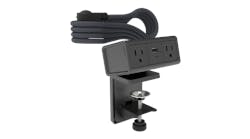Backpack vacuum cleaners play an important role in the commercial cleaning industry. As with any type of power equipment, the design of the unit can affect an operator's performance significantly. Because the operator wears the vacuum on his or her back, the total weight, weight distribution, sound level, harness comfort and air-discharge direction can affect operator fatigue, cleaning effectiveness, productivity and the potential for repetitive stress injuries.
Standard-setting organizations have not set specific ergonomic standards for backpack vacuums, but they do recognize the importance of proper design. The green-cleaning guidelines published in the LEED-EB rating system recommend that “power equipment be ergonomically designed to minimize vibration, noise and user fatigue.” However, except for noise level, LEED leaves it to equipment manufacturers to interpret the design specifics and encourages manufacturers to design ergonomic equipment.
Most backpack vacuums meet the noise standard, but differences among various designs can affect comfort, fatigue and productivity.
Backpack vacuums are similar in basic design. They generally consist of a motor housing and tank, a support harness that rests on the shoulders and hip girdle, and a hose, cleaning wand and various accessory heads. Although the designs are similar, research has shown that minor differences in weight, weight distribution, harness comfort, sound level and air-discharge direction can affect perceived effort, cleaning productivity and potential for repetitive stress injuries:
- Weight
Studies from the outdoor recreation industry indicate that carrying camping-style backpacks that exceed 13.2 pounds (6.0 kilograms) for extended periods may impair lung function, cause extensive skin irritation and risk thoracic nerve injury. This relates directly to carrying a backpack vacuum because the weight, harness design and typical duration of use are similar. Most backpack vacuums weigh less than this suggested upper limit, and a general design trend is the development of smaller and lighter units consistent with durability and good vacuuming performance.
- Perceived weight/weight distribution
Web Exclusive
Perceived weight is a subjective measure of weight that is influenced by total weight, harness design and weight distribution. Various studies have indicated that if a given weight is carried close to the body and higher on the back, there is less perceived weight. Conversely, when the weight is distributed low on the back or tends to lean away from the body, the perceived weight is significantly higher. In addition to restricting mobility, weight distributed low on the body tends to pull the shoulders back and put continuous strain on abdominal muscles.
- Harness
The design of a support harness is critical for distributing the weight of the backpack vacuum in a way that reduces perceived weight, while allowing sufficient mobility for effective cleaning. Harness comfort is a function of total surface-bearing area, padding thickness and density, and the flexibility, texture and resiliency of the harness materials. Backpack vacuums are worn by male and female operators, and harnesses must be adjustable to fit many body sizes. Harnesses with large bearing surfaces, good padding and a wide range of adjustability offer the best comfort.
- Sound level
LEED has established an upper limit of 70 dB(A) for all vacuums, including backpacks. Sound levels across brands vary from 59 dB(A) to 75 dB(A) for units with comparable vacuuming performance. High sound levels are known to increase stress and induce fatigue in workers.
- Air discharge
Because the operator of a backpack vacuum is wearing the device, proximity to the hot discharge air can create discomfort and fatigue. Backpack vacuums discharge their exhaust air in different ways: straight down; down at an angle away from the operator; straight back; or back and upward away from the operator.
Abrams, product manager for Advance, Plymouth, Minn.
- Read more on "Carpet maintenance tips" from the Carpet & Rug Institute (CRI)

